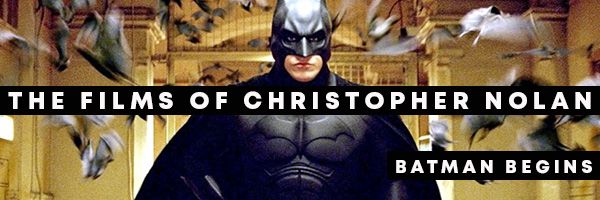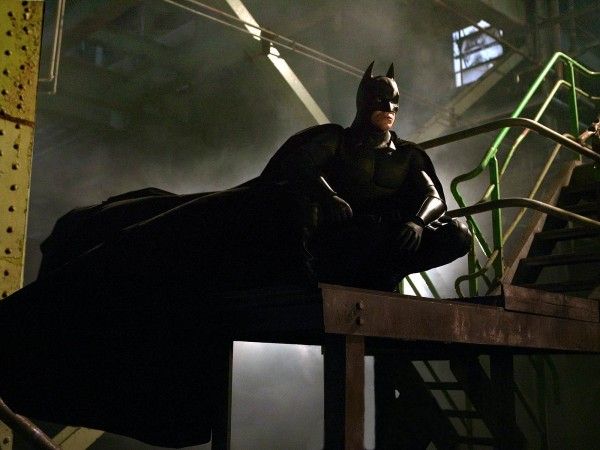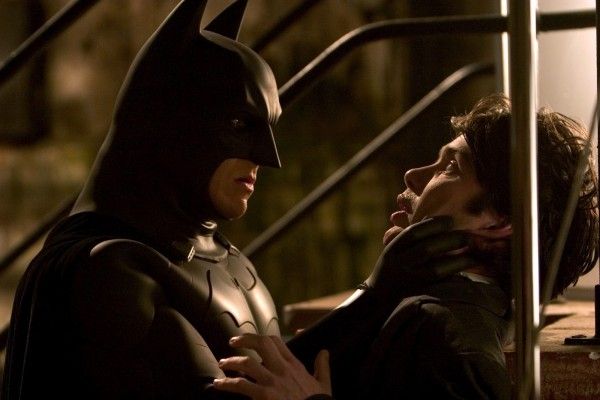Spoilers ahead for Batman Begins.
Christopher Nolan didn’t invent the origin story for superheroes, but he made sure that for the foreseeable future, origin stories would become the primary mode of rebooting franchises for over a decade. Until this point, characters were pretty much fleshed out in their debut adventure. There might be an explanatory first act followed by a montage like in Sam Raimi’s Spider-Man, but Nolan defined what studios would demand. “A gritty reboot in the vein of Batman Begins” may as well have been a macro in the Hollywood trades.
As we’ve seen in Nolan’s previous movies, motivations matter a great deal to the director. When Batman hit the big screen in 1989 with Tim Burton’s adaptation, it was enough for the film to basically be like, “Eh, this guy is kind of crazy and traumatized so that’s why he dresses up like a bat to fight crime.” For Nolan, that’s not good enough, so you get an entire film devoted to answering the “Why” of Batman rather than dropping the character into the story fully formed or only devoting the first act to his origin. The film meticulously goes over every element of the Caped Crusader right down to how they would be able to put together his cowl without arousing suspicion.
Drawing heavily from Frank Miller’s comic Batman: Year One, Nolan isn’t interested so much in the comic trappings of Batman, but instead is focused on trying to sell this as a real character within reason (he doesn’t go so far afield Darren Aronofsky’s pitch, in which Batman is a crazy homeless person who fights crime). The earliest Batman comics tell us that the reason Bruce Wayne dresses up like a Bat to fight criminals is that “criminals are a cowardly and superstitious lot.” So how do you translate that into a movie? How do you make the audience buy in to the reality of this crime fighter who doesn’t have any superpowers beyond his wealth, intelligence, and work ethic?
The genius concept that Nolan and co-writer David S. Goyer seize on is fear. Rather than making fear a one-way street where Bruce scares criminals, they instead decide to make it a part of his character as well as a part of the overall plot. In the typical Batman mythos, Thomas and Martha Wayne are gunned down outside a theater in Crime Alley by a mugger. The twist that Batman Begins provides is that they left the show early because young Bruce was scared of the bats that the opera reminded him of. In this way, Batman’s origin of losing his parents becomes wrapped in a notion of fear where Bruce sees how fear can drive people to tragic ends. He wants to use that fear against criminals rather than as it’s currently being used against the innocent. “Bats frighten me,” says Bruce. “It’s time my enemies shared my dread.” By making fear the cornerstone of the Batman origin, everything else falls into place as to why a billionaire would dress up like a rodent and fight crime.
The Batman movies needed a radically different approach after the negative reception to Batman & Robin and the franchise lay dormant for seven years before Nolan decided to reboot the character into the mold of a crime-thriller, but it works. Batman Begins is a successful relaunch because Nolan isn’t looking at his project like it’s a comic book (and some might argue that his trilogy’s shortcomings arise from his clear disdain anything that might resemble that medium), but rather that it takes place in a world similar to ours that happens to have a vigilante who dresses like a bat. Nolan’s Gotham has real-world issues like corrupt cops, gangsters, and bad neighborhoods. It’s a recognizable city far away from the gothic Tim Burton rendering or the candy-colored aesthetic of Joel Schumacher’s movies.
Nolan also stocks his movie not with hot stars but respected thespians. Christian Bale was an up-and-comer, but hardly a household name. But he had shown a devotion to his craft with unforgettable performances in movies like American Psycho and The Machinist. Nolan then proceeds to surround him with veterans like Michael Caine, Gary Oldman, Morgan Freeman, Liam Neeson, and Tom Wilkinson. The weirdest casting choice remains Katie Holmes, who simply doesn’t convey the gravitas required for the role despite giving an acclaimed performance a couple years earlier in the indie Piece of April. But the whole cast is a far cry from casting Chris O’Donnell and Alicia Silverstone because they’re young, attractive actors. In 2005, before superheroes had completely dominated the multiplex, Nolan and Warner Bros. made a bet that a new take on Batman would be enough to sell the film, and they were right.
The most surprising element of Batman Begins is that it still kind of elides the themes Nolan cares about. If there were ever a “one for them” movie, it’s Batman Begins, which is a radical new take on the character, but Nolan largely keeps his own interests out of sight, dedicating himself more to the reality of this new franchise rather than weaving in ideas about truth, lies, deception, and identity. Arguably, that’s part-and-parcel of a guy who has a secret identity, but Nolan doesn’t really go down that road. Instead, he commits himself to the reality of the universe he’s constructing right down to the believable character motivations.
Of course, Hollywood synthesized all this down into “gritty”, which isn’t necessarily what Nolan was going for. Yes, his Gotham is grimy and crime-ridden in a believable way, but I wouldn’t categorize Batman Begins as a joyless, grim-dark slog. It has humor! It has likable characters! It is, at its core, a summer tentpole that delivers on big, spectacular action with a well-known superhero. Nolan just worked within those confines to create something completely different and eschew the comic book aesthetic of something like the Spider-Man movies in favor of something closer to his own heart, which is a noir/thriller mold. While the nuts-and-bolts storytelling starts falling away in the third act, overall the film works because it has complete control over its tone and vision.
And yet it isn’t until we get to The Dark Knight that it feels like Nolan has fully realized what a Christopher Nolan Batman movie should be. The sequel encapsulates his signature themes rather putting them on the backburner. That’s not to dismiss Batman Begins or what it accomplishes in terms of blockbusters and superhero filmmaking, but if we’re looking through the lens of Nolan’s filmography, the movie is thematically anonymous as he devotes himself more to creating a concrete, realistic Batman. For Batman purists, it may not be the most “accurate” depiction of the character, and yet it works for what Nolan is attempting to create and refashion for a new generation.
Tomorrow: The Prestige




